
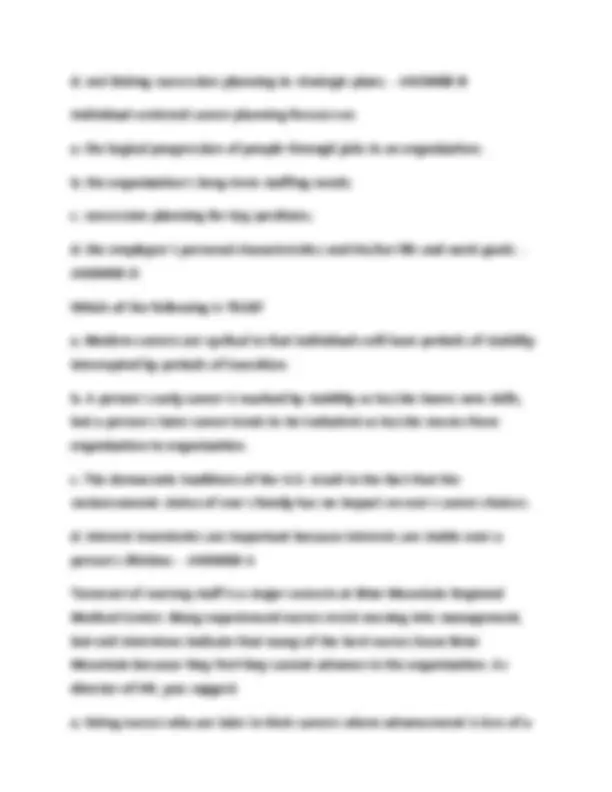
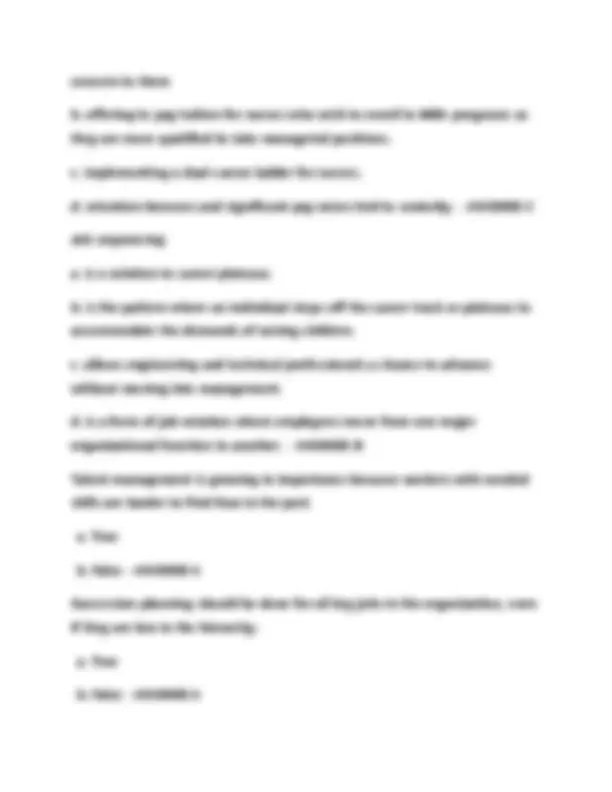
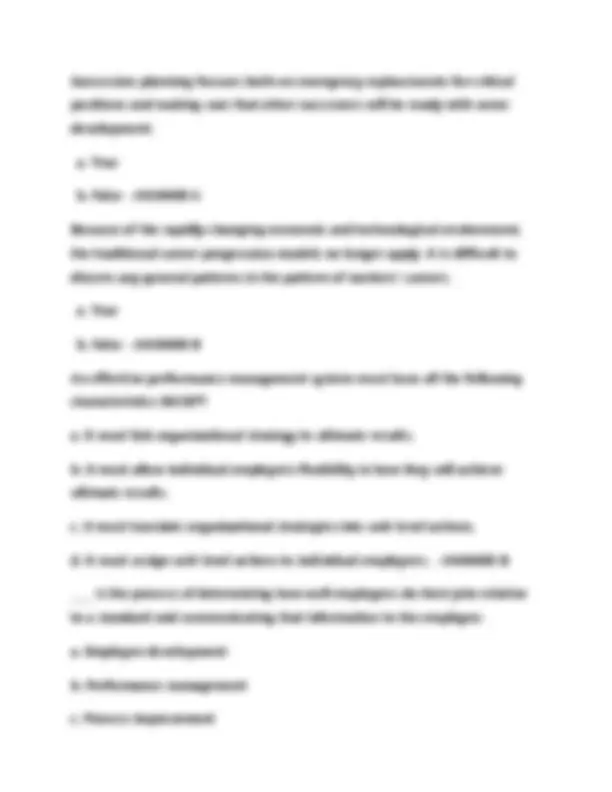
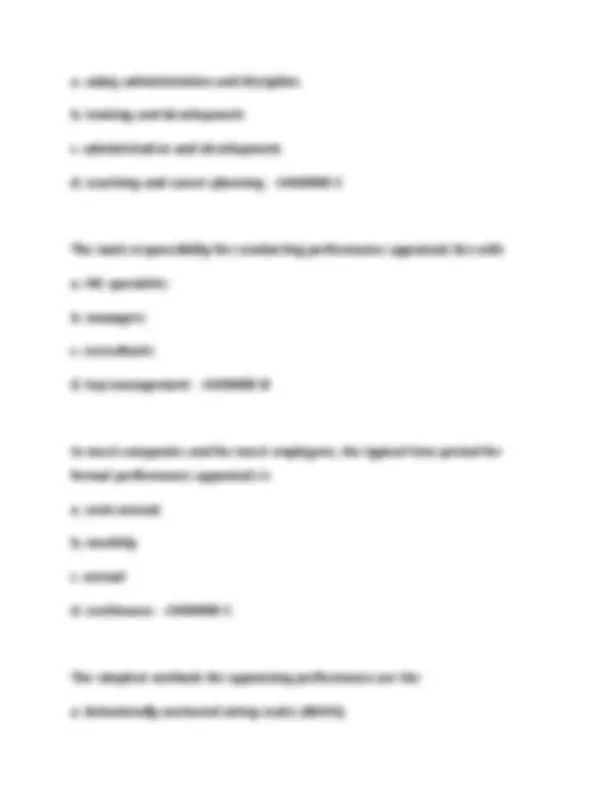
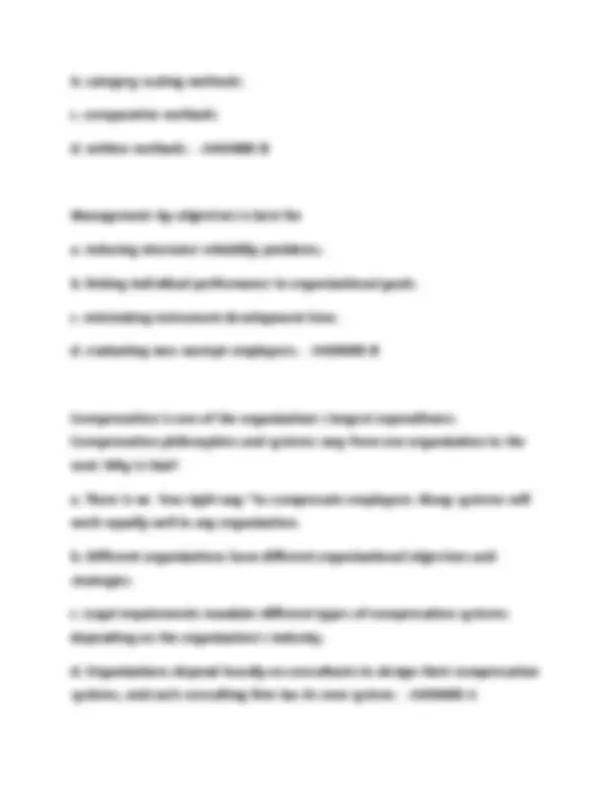
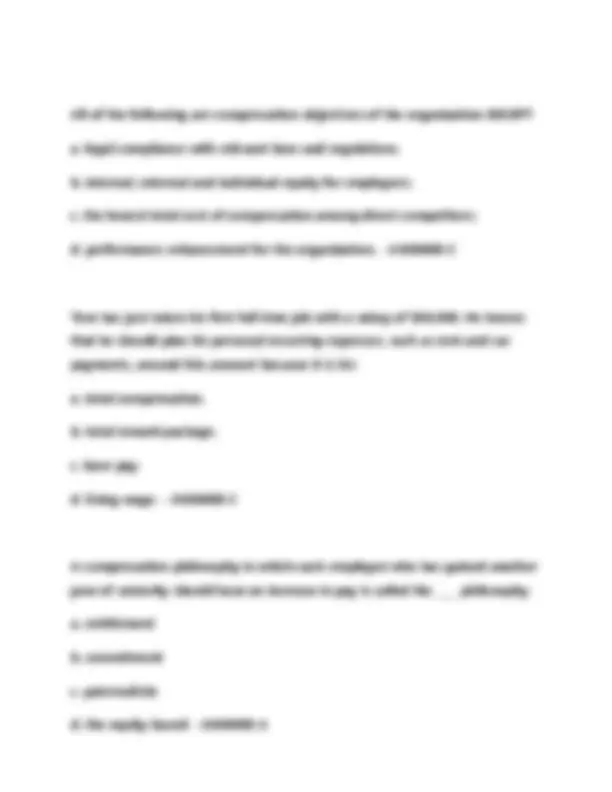
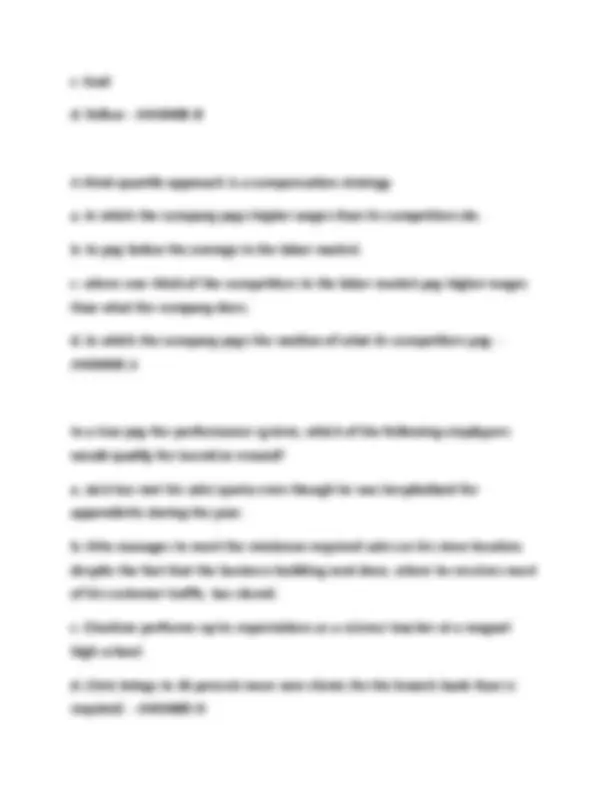
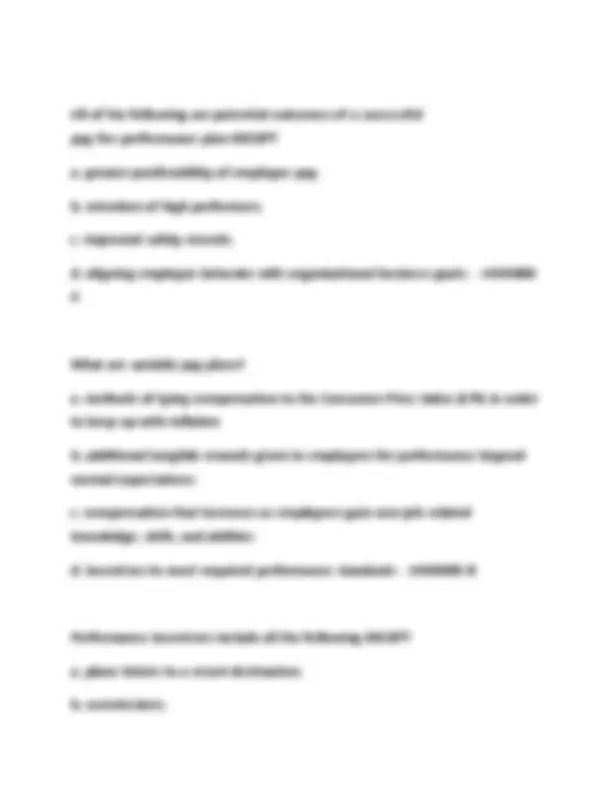
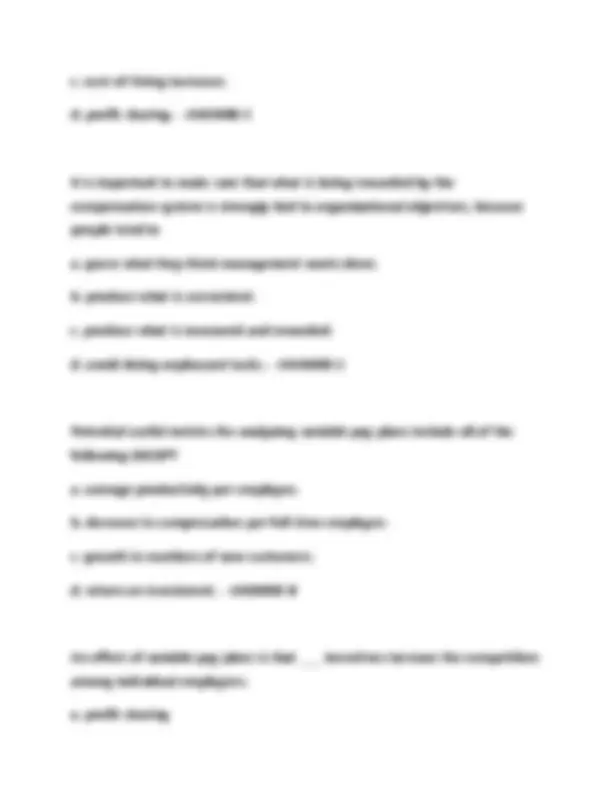
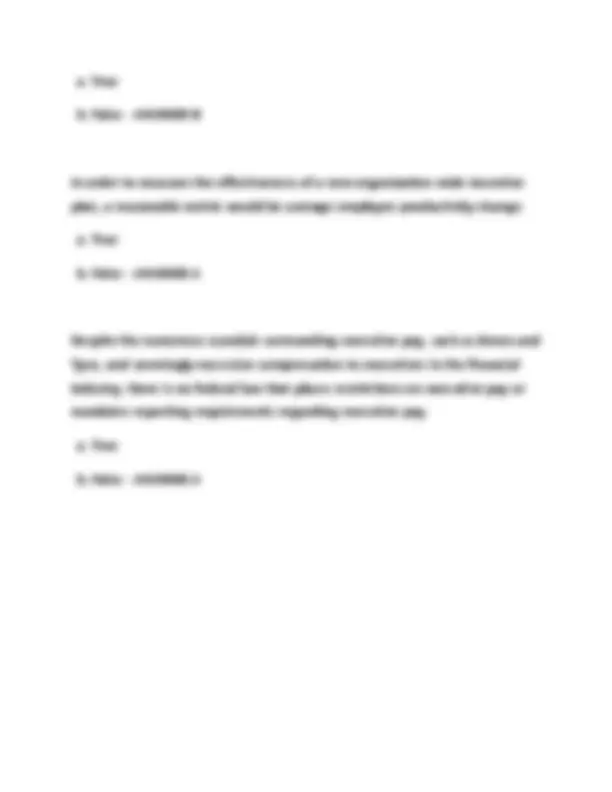


Study with the several resources on Docsity

Earn points by helping other students or get them with a premium plan


Prepare for your exams
Study with the several resources on Docsity

Earn points to download
Earn points by helping other students or get them with a premium plan
Community
Ask the community for help and clear up your study doubts
Discover the best universities in your country according to Docsity users
Free resources
Download our free guides on studying techniques, anxiety management strategies, and thesis advice from Docsity tutors
A series of multiple-choice questions and answers related to talent management, performance management, and compensation. It covers topics such as succession planning, career development, performance appraisal systems, and compensation philosophies. The questions test understanding of key concepts and principles in human resource management, making it a useful resource for students studying hr or preparing for exams. It provides insights into the importance of talent management in today's competitive environment and the various strategies organizations use to attract, develop, and retain talent. The document also touches on the legal and ethical considerations in performance management and compensation practices, offering a comprehensive overview of these critical hr functions.
Typology: Exams
1 / 18

This page cannot be seen from the preview
Don't miss anything!











The focus on talent management has intensified in the last few years due to all of the following factors EXCEPT a. decline in the proportion of the population aged 35 to 44. b. fewer numbers of young people entering the labor market in Europe. c. inadequate skills of new college graduates. d. the obsolescence of baby boomers' skills. - ANSWER D _____________is a process that moves people from recruiting and selection through the organization to meet the employer's need for talent. a. HR planning b. Training and development c. The HR flow process d. Talent management - ANSWER D Talent management includes all of the following HR activities EXCEPT a. training. b. job design. c. career planning. d. performance management. - ANSWER B
When succession plans are developed for CEOs and senior managers, HR needs major involvement from a. leadership consultants. b. headhunting firms. c. outside search committees. d. top executives and members of the board of directors. - ANSWER D The first step in the succession planning process is to a. decide whether to "make" or to "buy" talent. b. identify key employees and their anticipated retirement dates. c. define the positions that are critical to the organization's strategy. d. assess the capabilities of current employees. - ANSWER C A law that has impacted succession planning for CEOs is a. HIPAA. b. the Sarbanes-Oxley Act. c. ERISA. d. the Congressional Accountability Act. - ANSWER B All of the following are common mistakes in succession planning EXCEPT a. focusing succession planning only on the CEO and top executives. b. relying excessively on hiring external candidates. c. allowing the CEO to make all succession plan decisions.
concern to them b. offering to pay tuition for nurses who wish to enroll in MBA programs so they are more qualified to take managerial positions. c. implementing a dual-career ladder for nurses. d. retention bonuses and significant pay raises tied to seniority. - ANSWER C Job sequencing a. is a solution to career plateaus. b. is the pattern where an individual steps off the career track or plateaus to accommodate the demands of raising children. c. allows engineering and technical professionals a chance to advance without moving into management. d. is a form of job rotation where employees move from one major organizational function to another. - ANSWER B Talent management is growing in importance because workers with needed skills are harder to find than in the past. a. True b. False - ANSWER A Succession planning should be done for all key jobs in the organization, even if they are low in the hierarchy. a. True b. False - ANSWER A
Succession planning focuses both on emergency replacements for critical positions and making sure that other successors will be ready with some development. a. True b. False - ANSWER A Because of the rapidly changing economic and technological environment, the traditional career progression models no longer apply. It is difficult to discern any general patterns in the pattern of workers' careers. a. True b. False - ANSWER B An effective performance management system must have all the following characteristics EXCEPT a. it must link organizational strategy to ultimate results. b. it must allow individual employees flexibility in how they will achieve ultimate results. c. it must translate organizational strategies into unit-level actions. d. it must assign unit-level actions to individual employees. - ANSWER B ____ is the process of determining how well employees do their jobs relative to a standard and communicating that information to the employee. a. Employee development b. Performance management c. Process improvement
d. tend to have significantly higher financial results compared with other types of organizational cultures. - ANSWER D
Michael, the owner of a moving company, has developed a performance appraisal system for his customer representatives and truck drivers. He evaluates each of these employees on accuracy of weight estimates, meeting delivery deadlines, and dollar value of breakage. Michael's performance appraisal system is ____ based. a. trait b. results c. behavior d. productivity - ANSWER B
____ define the level of performance that is expected by an employee. a. Job criteria b. Job expectations c. Performance standards d. Essential elements - ANSWER C
The two general uses of performance appraisal, which are often in conflict, are
a. salary administration and discipline. b. training and development. c. administrative and development. d. coaching and career planning - ANSWER C
The main responsibility for conducting performance appraisals lies with a. HR specialists b. managers c. consultants d. top management - ANSWER B
In most companies and for most employees, the typical time period for formal performance appraisals is a. semi-annual. b. monthly c. annual d. continuous - ANSWER C
The simplest methods for appraising performance are the a. behaviorally anchored rating scales (BARS).
All of the following are compensation objectives of the organization EXCEPT a. legal compliance with relevant laws and regulations. b. internal, external and individual equity for employees. c. the lowest total cost of compensation among direct competitors. d. performance enhancement for the organization. - ANSWER C
Tom has just taken his first full time job with a salary of $58,000. He knows that he should plan his personal recurring expenses, such as rent and car payments, around this amount because it is his a. total compensation. b. total reward package. c. base pay. d. living wage. - ANSWER C
A compensation philosophy in which each employee who has gained another year of seniority should have an increase in pay is called the ____ philosophy. a. entitlement b. commitment c. paternalistic d. the equity-based - ANSWER A
The two basic compensation philosophies, which should be seen as opposite ends of a continuum, are the ____ and the ____ orientations. a. competency, productivity b. exempt; non-exempt c. entitlement; performance d. market-driven, equity-driven - ANSWER C
Which type of compensation is linked directly to individual, team, or organizational performance? a. variable pay b. direct pay c. wages d. Salary - ANSWER A
At Artistic Floral Creations, the non-managerial employees all receive the same pay increase every year. Usually this increase is about 5%, but some years it has been as high as 10% depending on changes in the cost-of-living. Artistic Floral Creations has a/an ____ philosophy of compensation. a. performance b. entitlement
c. lead d. follow - ANSWER B
A third-quartile approach is a compensation strategy a. in which the company pays higher wages than its competitors do. b. to pay below the average in the labor market. c. where one-third of the competitors in the labor market pay higher wages than what the company does. d. in which the company pays the median of what its competitors pay. - ANSWER A
In a true pay-for-performance system, which of the following employees would qualify for incentive reward? a. Jack has met his sales quota even though he was hospitalized for appendicitis during the year. b. Otto manages to meet the minimum required sales on his store location despite the fact that the business building next door, where he receives most of his customer traffic, has closed. c. Charlene performs up to expectations as a science teacher at a magnet high school. d. Chris brings in 20 percent more new clients for the branch bank than is required. - ANSWER D
All of the following are potential outcomes of a successful pay-for-performance plan EXCEPT a. greater predictability of employee pay. b. retention of high performers. c. improved safety records. d. aligning employee behavior with organizational business goals. - ANSWER A
What are variable pay plans? a. methods of tying compensation to the Consumer Price Index (CPI) in order to keep up with inflation b. additional tangible rewards given to employees for performance beyond normal expectations c. compensation that increases as employees gain new job-related knowledge, skills, and abilities d. incentives to meet required performance standards - ANSWER B
Performance incentives include all the following EXCEPT a. plane tickets to a resort destination. b. commissions.
b. individual c. work team d. organizational - ANSWER B
If managers wish to motivate individual contributions to team performance, an equitable distribution of team incentives would mean that a. each team member gets the same amount of bonus. b. team members are paid incentives which vary according to individual performance. c. teams that are in competition with one another are paid incentives based on their relative performance. d. each team in the company receives the same amount of discretionary incentive dollars to distribute. - ANSWER B
The purpose of organizational-level incentives is to a. reward each employee for the performance of the entire company. b. aid in recruiting individualistic and entrepreneurial employees. c. motivate functional competition among employees to increase total performance. d. create an organizational culture of ethical behavior. - ANSWER A
For a profit-sharing plan to be effective, management must a. increase innovative solutions to technical problems. b. not have high expectations of performance impact in the first year of the program. c. be willing to disclose accurate financial and profit information to employees. d. stabilize profits so that the annual payout is consistent. - ANSWER C
The most widely used long-term performance incentives for executives is/are a. generous perquisites. b. 401ks. c. stock options. d. annual cash incentives. - ANSWER C
Because of the difficulties of designing a truly functional incentive system, fewer than half of all organizations use variable pay. a. True b. False - ANSWER B
Some form of individual performance incentive is appropriate for every organization.